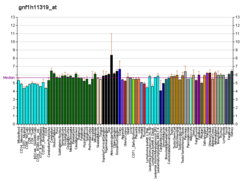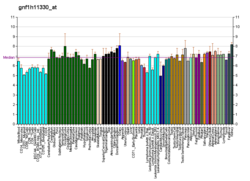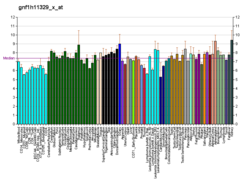| OR8B4 |
|---|
|
| Identifiers |
|---|
| Aliases | OR8B4, OR11-315, OR8B4P, olfactory receptor family 8 subfamily B member 4 (gene/pseudogene), olfactory receptor family 8 subfamily B member 4 |
|---|
| External IDs | MGI: 3030712; HomoloGene: 17395; GeneCards: OR8B4; OMA:OR8B4 - orthologs |
|---|
| Gene location (Human) |
|---|
 | | Chr. | Chromosome 11 (human)[1] |
|---|
| | Band | 11q24.2 | Start | 124,423,942 bp[1] |
|---|
| End | 124,424,871 bp[1] |
|---|
|
| Gene location (Mouse) |
|---|
 | | Chr. | Chromosome 9 (mouse)[2] |
|---|
| | Band | 9|9 A4 | Start | 37,829,136 bp[2] |
|---|
| End | 37,833,770 bp[2] |
|---|
|
| RNA expression pattern |
|---|
| Bgee | | Human | Mouse (ortholog) |
|---|
| | Top expressed in | - secondary oocyte
- primary oocyte
- zygote
|
| | More reference expression data |
|
|---|
| BioGPS | 

 | | More reference expression data |
|
|---|
|
| Gene ontology |
|---|
| Molecular function | - G protein-coupled receptor activity
- odorant binding
- olfactory receptor activity
- signal transducer activity
| | Cellular component | - integral component of membrane
- plasma membrane
- membrane
| | Biological process | - sensory perception of smell
- signal transduction
- response to stimulus
- detection of chemical stimulus involved in sensory perception of smell
- G protein-coupled receptor signaling pathway
| | Sources:Amigo / QuickGO |
|
| Orthologs |
|---|
| Species | Human | Mouse |
|---|
| Entrez | | |
|---|
| Ensembl | | |
|---|
| UniProt | | |
|---|
| RefSeq (mRNA) | | |
|---|
| RefSeq (protein) | | |
|---|
| Location (UCSC) | Chr 11: 124.42 – 124.42 Mb | Chr 9: 37.83 – 37.83 Mb |
|---|
| PubMed search | [3] | [4] |
|---|
|
| Wikidata |
| View/Edit Human | View/Edit Mouse |
|





















